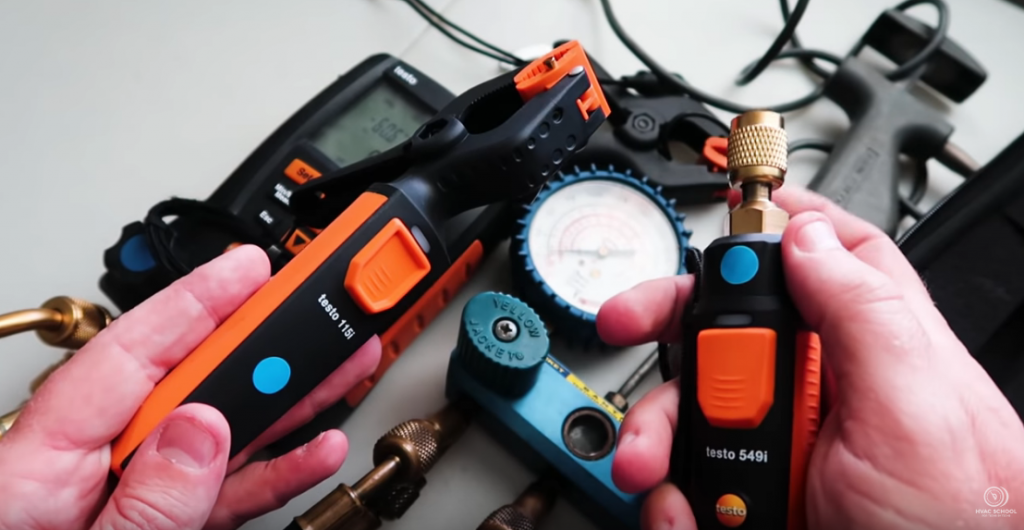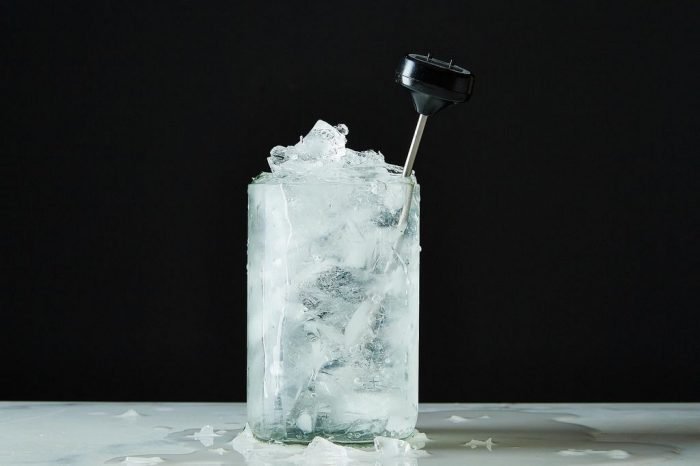Get Tech Tips
Subscribe to free tech tips.
Negative Superheat? Time to Check Your Tools

I was fresh out of school, working as an apprentice at my first real HVAC job, and I was listening in on a shop conversation between a few techs.
They were talking about finding so many overcharged systems. One of the techs turns to me and says, “I had a unit yesterday that was so overcharged it was running minus five degrees of superheat.” I don't remember EXACTLY what I said in response to that, but it started a miniature argument and set me on a crusade against misinformation that led me here all these years later.
When in doubt, check your tools.
Before we move on, I want to mention something that Jeremy Smith pointed out to me. When working with a zeotropic refrigerant blend with “glide,” the change from liquid to vapor and vapor to liquid occurs over a range of temperatures, not at a single temperature. When calculating superheat, we use the “dew point.” We use the “bubble point when calculating subcooling. The saturation temperature is the range of temperatures between those two points; a temperature could be “interpreted” as negative superheat or subcooling when it is actually just in the saturated range. In air conditioning, the traditional R-22 and R-410a refrigerants do not have any significant glide, but newer blends do, so that's something to watch out for.
Here is a list of things that, if you observe them, it will be worth checking your tools to make sure they are set up correctly, connected correctly, and properly calibrated BEFORE you start making an exotic diagnosis:
Negative Superheat
Superheat is the temperature gained in the refrigerant once it has completely boiled into a vapor. When it is still boiling, it will be in a mixed state and will be at saturation temperature for that given pressure. Zero superheat is something you will often see when a system has a flooded coil; zero superheat indicates that liquid is still boiling in the suction line. While that generally isn't a good thing, it is something that you will observe from time to time. It will usually result in you as the tech taking corrective action.
Negative superheat goes by another name: SUBCOOLING. The only way a substance can be in the subcooled range is if it is 100% liquid and has given off additional heat below the saturated (mixed) state. In a running air conditioning system, it's impossible for the suction line to be 100% liquid subcooled below saturation; therefore, it is impossible to have negative superheat both by definition or in practice.
“So, what happens when you measure negative superheat?” you may ask. Good question.
It is one of a few possibilities:
- You are looking at the wrong refrigerant PT scale.
- The refrigerant is mixed (somebody added another refrigerant on top of the original refrigerant).
- You are dealing with a blended refrigerant with “glide,” like many of the new 4-series blends, such as R-407c.
- Your suction gauge is reading too high.
- Your line clamp thermometer is reading too low.
- You do not have a good connection on the line, the Schrader core isn't depressing, or the King valve isn't open.
- A combination of the items listed above.
Negative Subcooling
Just as we mentioned above, negative subcooling is actually a superheat condition. There is no such thing as negative subcooling.
Is it possible for the liquid line to contain superheated vapor? It is THEORETICALLY possible but not practical. For example, if someone short-circuited nearly the entire condensing coil and connected to the liquid line, you could see superheated vapor—but let's be realistic.
When techs measure a negative subcooling (superheat) at the liquid line, it could be:
- You are looking at the wrong refrigerant PT scale.
- The refrigerant is mixed (somebody added another refrigerant on top of the original refrigerant).
- You are dealing with a blended refrigerant with “glide,” like many of the new 4-series blends such as R407c.
- Your high side gauge is reading too low.
- Your line clamp thermometer is reading too high.
- You do not have a good connection on the line, the Schrader core isn't depressing, or the King valve isn't open.
- A combination of the items listed above.
Liquid Line Cooler than the Outdoor Air
There are two cases where the liquid line can be cooler than the outdoor air when measured at the condenser outlet:
- A wet coil
- A restriction inside the condenser cabinet in the liquid line, usually in a factory-installed filter drier
Because the liquid line temperature will often be VERY close to the outdoor temperature on a new, high-efficiency system, you may often measure a liquid line as colder than the outdoor air when that may not really be the case.
Often, you may SEE a liquid line colder than the outdoor ambient, and it may simply be:
- Miscalibration of the line clamp or the ambient air thermometer
- Measurement of the ambient air in sunlight where the probe can be affected by sunlight
- The coil is still damp after cleaning or rain (evaporative cooling)
It's always a good practice to have a backup set of thermometers and gauges so that you can double-check the calibration of your tools against one another. Whenever possible, test them under the conditions that you are using them.

If you have two clamps, place them on the same line right next to one another. When testing two air probes, stick them both in the same return air stream side by side. You may also test in an ice bath (demonstrated HERE); just make sure that the water is pure and that the water and ice are fully mixed and circulating when you test for 32°F (0°C).
Also, keep in mind that every measurement device has “uncertainty” in the measurement of +/- a certain amount, depending on the tool. Don't expect your tools to provide greater accuracy than what is published in their specifications.
—Bryan











Comments
Two of everything is good! Back up plans….
Two of everything is good! Back up plans….
Great post Bryan.
I have overheard other techs seriously discussing “negative superheat” before, I agree with you about battling mis-information in our trade.
I’d like to share one rule of thumb that I learned long ago.
~ If you have liquid at vapour saturation there can be NO SUPERHEAT.
~ If you gas / flash gas at liquid saturation there can be NO SUBCOOLING.
I would, however, like to contribute to our trade by coining some new terminology that will hopefully help to clear up the matter at hand.
Instead of using the terms “negative superheat” or “negative subcooling”, I propose that we use the terms “subheat” for negative superheat and “supercooling” for negative subcooling, that should help to clarify the subject for everyone…
Have a good day.
Great post Bryan.
I have overheard other techs seriously discussing “negative superheat” before, I agree with you about battling mis-information in our trade.
I’d like to share one rule of thumb that I learned long ago.
~ If you have liquid at vapour saturation there can be NO SUPERHEAT.
~ If you gas / flash gas at liquid saturation there can be NO SUBCOOLING.
I would, however, like to contribute to our trade by coining some new terminology that will hopefully help to clear up the matter at hand.
Instead of using the terms “negative superheat” or “negative subcooling”, I propose that we use the terms “subheat” for negative superheat and “supercooling” for negative subcooling, that should help to clarify the subject for everyone…
Have a good day.
I am tired of these negative superheat articles. Can’t we focus on the positive things about superheat? Negative superheat is “fake news” for sure.
I am tired of these negative superheat articles. Can’t we focus on the positive things about superheat? Negative superheat is “fake news” for sure.
Not fake news, I have this issue right now. I just moved into a townhouse unit isn’t cooling properly and is running all day. I’m using test 550 with clamps also checked with k type still same readings.
Not fake news, I have this issue right now. I just moved into a townhouse unit isn’t cooling properly and is running all day. I’m using test 550 with clamps also checked with k type still same readings.
I found a system with negative superheat today. 407C, but I trust my fieldpiece probes and doublechecked w/ other equipment. You could hear a faint hissing sound if you put your ear to the condensing unit. Either the internal portion of the discharge line or the seal on the muffler was leaking past raising suction pressure and subsequently suction saturation calculated by the fieldpiece lograrithm. What refrigerant that WAS making it through the system was returning on the suction line as a superheated vapor at a temperature less than what was calculated by the suction pressure probe; hence, negative superheat. When I get that compressor back to the shop my apprentice will cut it open and we’ll find the “hot gas bypass” causing that “negative superheat”
I found a system with negative superheat today. 407C, but I trust my fieldpiece probes and doublechecked w/ other equipment. You could hear a faint hissing sound if you put your ear to the condensing unit. Either the internal portion of the discharge line or the seal on the muffler was leaking past raising suction pressure and subsequently suction saturation calculated by the fieldpiece lograrithm. What refrigerant that WAS making it through the system was returning on the suction line as a superheated vapor at a temperature less than what was calculated by the suction pressure probe; hence, negative superheat. When I get that compressor back to the shop my apprentice will cut it open and we’ll find the “hot gas bypass” causing that “negative superheat”
I found a system with “negative superheat” today. 407C, but I trust my probes and doublechecked with other equipment. You could hear a hissing sound coming from the compressor if you listened closely. Either the internal portion of the discharge line or the muffler head had a leak and was bypassing hot gas into the shell. This raised suction saturation as calculated by the fieldpiece algorithm in my phone’s app from the low side pressure probe. Nevertheless, some refrigerant made it through the system and returned as superheated vapor, at a temperature lower than the calculated suction saturation. When I cut that joker open I will post photos on my linkedin (Adam Deckard) of the “hot gas bypass”.
I found a system with “negative superheat” today. 407C, but I trust my probes and doublechecked with other equipment. You could hear a hissing sound coming from the compressor if you listened closely. Either the internal portion of the discharge line or the muffler head had a leak and was bypassing hot gas into the shell. This raised suction saturation as calculated by the fieldpiece algorithm in my phone’s app from the low side pressure probe. Nevertheless, some refrigerant made it through the system and returned as superheated vapor, at a temperature lower than the calculated suction saturation. When I cut that joker open I will post photos on my linkedin (Adam Deckard) of the “hot gas bypass”.
To leave a comment, you need to log in.
Log In